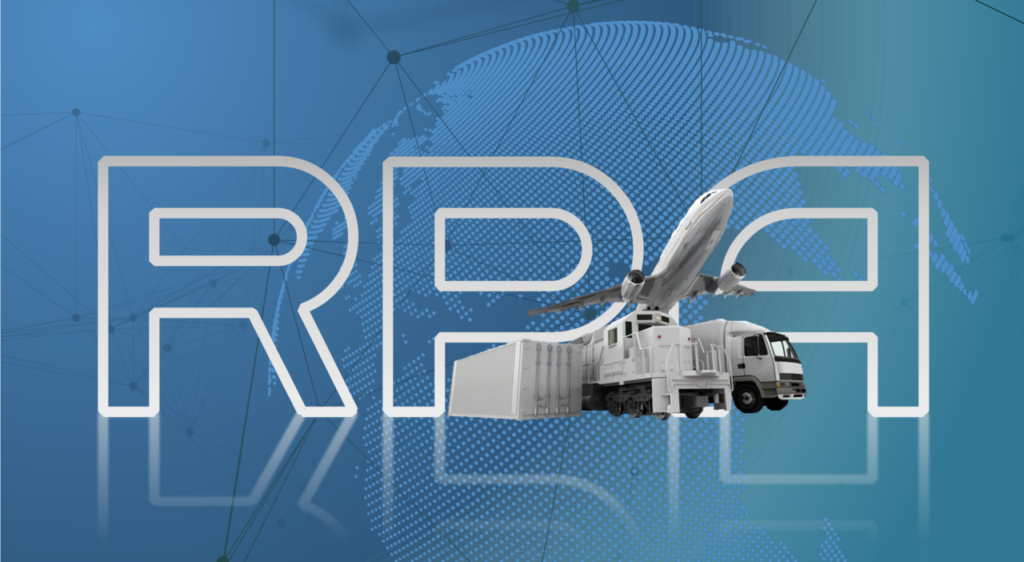The supply chain is notorious for the amount of paperwork required to move products around the globe. Nevertheless, the information contained in that paperwork is critical for the supply chain’s smooth operation. “In an industry inundated with paper,” writes Brian Belcher, Co-founder and Chief Operating Officer of Vector, “it’s a mystery how operations will continue to efficiently expand. … Paper costs the supply-chain industry upwards of $3 billion every year (not counting the additional price tag of paper, ink and printing). In addition, paper results in a lack of visibility, efficiency, and sustainability, as well as undermining the safety of drivers. With the cons of paper more than outweighing the pros, it’s time the supply chain underwent an industry-wide transformation.”[1] Of course, the term “paperwork” is a euphemism for recording transactions be they digital or physical. Even digital paperwork can be time-consuming and error-prone. Which is why robotic process automation (RPA) can play an important supply chain role.
A couple of years ago, Corrie White, Marketing Manager at Transfix, reported that new technologies were “flooding the freight industry” in an effort to make operations more efficient and effective.[2] Among those technologies was robotic process automation. She wrote, “A fast-growing technology that imitates human behavior and has taken root in the financial services and hospitality industries is slowly making its way into logistics. Robotic process automation is an intelligent automation software that uses machine learning, natural language processing, and artificial intelligence to mimic the rote tasks a human performs on a daily basis, whether it’s reading email or quoting rates. Eventually, RPA technology could provide every broker an assistant to perform lower-level tasks so they can so they can focus on high-level strategy.” What White described was not your run-of-the-mill RPA. RPA is not intelligent — it’s rules-based. Boyd Bell, CEO of Useful Rocket Science, explains, “RPA [has] its limitations. As early robotics adopters learned 30+ years ago, these technologies fail when asked to work on complex tasks. It doesn’t work for shades of gray and processes involving a lot of individual decisions, but rather excels on simple tasks or a series of tasks where there is no interpretation required.”[2] What White described is referred to as intelligent robotic process automation, cognitive robotic process automation, or, as we call it at Enterra Solutions®, Cognitive Process Automation™.
Robotic Process Automation vs. Cognitive Process Automation
As I noted above, traditional RPA solutions are rules-based. Leslie Willcocks, a professor at the London School of Economics, defines RPA as taking “the robot out of the human.”[3] He explains, “The average knowledge worker employed on a back-office process has a lot of repetitive, routine tasks that are dreary and uninteresting. RPA is a type of software that mimics the activity of a human being in carrying out a task within a process. It can do repetitive stuff more quickly, accurately, and tirelessly than humans, freeing them to do other tasks requiring human strengths such as emotional intelligence, reasoning, judgment, and interaction with the customer.”[3] Greg Council, Director of Product Marketing at ImageSource, adds, “RPA is founded on an early example of expert systems. This form of AI simply entails encoding the knowledge of a subject-matter expert for a given task into a set of rules that a computer-based system can execute. As such, the more specific and well known the given task, the better RPA is at successfully automating it. But RPA software lacks built-in ‘intelligence’.”[4]
If you want to add a little reasoning and judgment into RPA, then some artificial intelligence (AI) must be added. RPA is often referred to as a gateway technology for artificial intelligence. Council explains adding machine learning to some RPA processes can have value. “Most ‘bots’ — a term that identifies a specific automation routine — only work against given rule sets in structured processes,” he writes. “They don’t adapt to new scenarios or learn from mistakes. This realm of AI is called ‘machine learning.’ The most mature (but still relatively new) RPA application of machine learning is the advance of ‘learn by example’ into the bot-configuration process, where a system can monitor — completely in the background — a given SME’s actions for different situations. This monitoring manifests itself as a ‘learned’ set of rules that can be implemented once complete, and it can be superior and more flexible than traditional rule-based approaches.” In other words, Cognitive Process Automation is able to Sense, Think, Act, and Learn®.
Process Automation in Retail and the Supply Chain
The retail sector of the supply chain can benefit as much from process automation as other areas of the supply chain. Guy Kirkwood, former chief evangelist at UiPath, observes, “It’s no secret that the retail sector is going through a monumental transformation, whether bricks and mortar or online. Consequently, it has never been more important to take stock of business processes, assess where efficiencies can be made, and determine how technology can be maximized to offer a compelling proposition of both superior customer experience and operational improvement.”[5] He believes RPA is a good starting point. He explains, “Implemented effectively in the retail sector, automation can generate huge productivity benefits across numerous areas — retail supply chain (including forecasting), through the back-office (including invoice processing) and onto the shop floor (including store planning).” He goes on to explain:
“RPA is of particular relevance in retail, given the level of automation on which the industry depends, and the vast data management required. In a retail environment, software robots can automate essential, standard, high-volume, repeatable, rule-based processes, from supply chain right through to post-purchase. In the supply chain, software robots are able to analyze and make actions based on data patterns — for example, triggering alerts or processes. This is particularly useful for retailers working with short supply times and especially in today’s heightened customer experience environment. Back-office tasks ripe for RPA include financial processes — invoice processing, bill checking, and payments and HR process-related functions e.g., onboarding and offboarding employees, a time-consuming process in a sector that relies heavily on seasonal employees. In the front office, RPA is ideal in call centers, chatbot operation and data-driven behavioral analysis — as well as workforce management, trade promotions and store planning. Studies have reported that automation can generate an accuracy rate of 98% in retail product categorization, whilst reducing human effort by 80%.”
Peter Bendor-Samuel, founder and CEO of Everest Group, concludes, “Although RPA technology is relatively easy and inexpensive to implement, it’s far more than a labor-to-technology substitution. Because digital transformation takes and end-to-end approach in business processes, it opens new issues around how processes should be designed. That leads to new issues in service delivery. In short: RPA adoption could change everything about services supply chains and delivering value.”[6]
Footnotes
[1] Brian Belcher, “When Will Supply Chains Finally Move on From Paper?” SupplyChainBrain, 31 March 2021.
[2] Corrie White, “Why robotic process automation (RPA) is the perfect technology for logistics,” FreightWaves, 10 March 2020.
[3] Xavier Lhuer, “The next acronym you need to know about: RPA (robotic process automation),” McKinsey & Company, December 2016.
[4] Greg Council, “Injecting (Artificial) Intelligence into Robotic Process Automation,” Experfy, 2 May 2018.
[5] Guy Kirkwood, “Retail’s future lies in Robotic Process Automation,” ChannelX, 2 August 2019.
[6] Peter Bendor-Samuel, “Robotic process automation is reworking supply chains,” CIO United States, 1 May 2018.





